
Organizations across industries are compelled to adopt innovative strategies to remain competitive, efficient, and customer-focused. Digital transformation is not merely the adoption of new technologies but a comprehensive evolution that hinges on seamless integration, usability, risk-managed experimentation, automation, and operational efficiency.
The below strategies address critical challenges such as interoperability gaps, low system adoption, business continuity risks, skill shortages, and operational inefficiencies, enabling enterprises to drive sustainable growth, agility, and superior user experiences in a complex digital world.
5 Strategies for Successful Digital Transformation
Digital transformation is essential for organizations to remain competitive and resilient in today’s fast-evolving business environment. This document presents a comprehensive set of strategies that combine advanced technologies with cultural and organizational change to address key challenges such as legacy systems, data silos, cybersecurity, and workforce adaptability. By following these strategies, organizations can build scalable, agile, and customer-centric digital ecosystems that drive innovation and sustainable growth. Practical implementation steps, industry tools, and proven examples provide a clear roadmap for leaders to successfully navigate their digital transformation journey.
1. Create Integrative Digital Solutions that can Connect with Other Digital Systems
Integrative digital solutions refers to technologies or platforms designed to interface and interoperate with multiple existing and future digital systems. This digital transformation strategy is adopted across various industries such as finance, healthcare, government, retail, logistics and manufacturing, where the systems often operate in Silos, creating data fragmentation and inefficiencies.
The key challenges this strategy addresses is lack of interoperability, which results in duplicated efforts, communication breakdowns and rigid infrastructures that cannot scale to meet modern requirements. By connecting systems through this strategy integration, organizations can address the challenges of data inconsistency, slow innovation cycles and inefficient workflow.
To implement this strategy, organizations must
- Conduct an audit of their current digital environment to identify the systems that need integration and understand existing bottlenecks.
- Should define clear integration goals, such as reducing software silos, enabling ERP-CRM syncs, or linking core financial tools.
- Must choose a robust integration approach, whether through APIs, middleware, or enterprise service buses (ESBs).
- Pilot projects should be deployed on a small scale before scaling up.
- Companies should ensure that security, governance, and compliance standards are embedded from the outset.
Globally, several tools and technologies have become critical for achieving this integration. Widely valued are as follows:
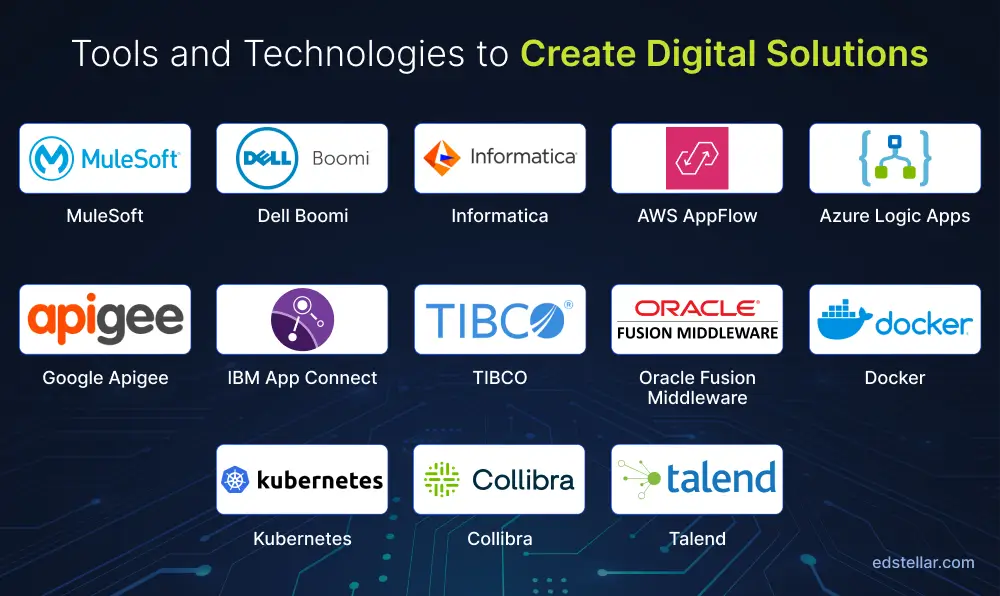
- Application Programming Interfaces (APIs)
- Microservices Architecture
- Middleware Platforms such as MuleSoft, Dell Boomi, or Informatica
- Cloud Integration Platforms such as AWS AppFlow, Azure Logic Apps, Google Apigee
- iPaaS (Integration Platform as a Service) tools
- Enterprise Service Bus (ESB) technologies such as IBM App Connect, TIBCO, and Oracle Fusion Middleware
- Containerization technologies such as Docker and Kubernetes
- Data governance technologies such as Collibra and Talend
Here is a case study of using integrative digital solutions to connect with other digital systems:
- In healthcare, Epic Systems and Cerner have implemented standards-based integration using FHIR (Fast Healthcare Interoperability Resources) to interconnect electronic health records across hospitals and clinics. This has allowed doctors and insurers to access unified patient records, improving care quality and reducing operational inefficiencies.
- Walmart has connected supply chain platforms using cloud-based integration, enabling real-time visibility from suppliers to consumers, which shortened delivery times during the COVID-19 pandemic.
- In financial services, JP Morgan Chase utilized MuleSoft’s API-led connectivity approach to integrate legacy banking infrastructure with modern blockchain and AI-powered finance tools, enabling faster settlement and fraud detection.
2. Develop User-friendly Digital Systems
User-friendly digital systems are web applications that prioritise ease of use, intuitive interfaces and efficient experiences for both employees and end-users. These systems are used across industries such as e-commerce, banking, healthcare, government services, education, and manufacturing, where digital adoption depends on how accessible and intuitive platforms are.
The main challenges addressed by this strategy is low adoption rates, caused by overly complex tools, confusing user interfaces, and steep learning curves, and poorly designed systems often result in employee frustration, errors, and inefficiencies, which undermine the goals of digital transformation.
Steps to implement this user-friendly digital strategy are as follows:
- Implementation is conducting user research to understand workflows, pain points, and expectations.
- Design teams should apply Human-Centered Design (HCD) or Design Thinking principles to develop prototypes that emphasize simplicity, clarity, and functionality.
- Organizations should engage in iterative testing, gathering user feedback at every stage to refine the design
- Access standards, such as WCAG (Web Content Accessibility Guidelines), must be embedded to ensure inclusivity across diverse user groups
- Companies should deploy continuous improvement processes, where real-time user data informs iterative updates and system enhancements.
To build user-friendly systems, organizations often leverage specific tools and frameworks, including popular interface design tools such as
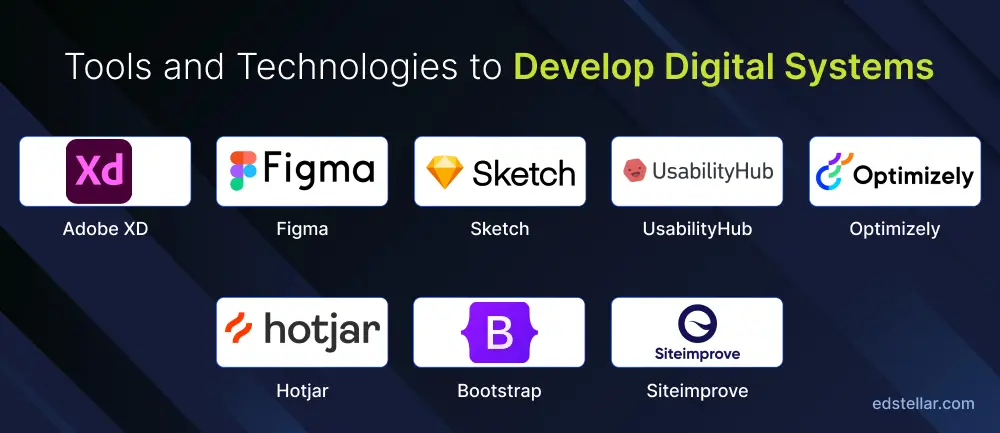
- Use Adobe XD, Sketch and Figma, while testing platforms such as UsabilityHub, Optimizely, and Hotjar support iterative feedback collection.
- Companies employ UI/UX frameworks such as Material Design, Bootstrap, and Fluent Design to maintain consistency.
- For accessibility compliance, solutions such as Deque Axe and Siteimprove help organizations stay aligned with global standards.
- Across industries, organizations value agile methodologies, DevOps frameworks, cloud-native development environments, and customer analytics platforms to enhance the continuous evolution of digital systems.
Here is a case study helping your company understanding why developing user-friendly digital systems is important:
- In banking, Revolut built highly user-friendly financial platforms, transforming how customers interact with digital banking by prioritizing seamless onboarding, simple navigation, and personalized dashboards.
- In e-commerce, Amazon maintains its leadership partly due to an obsession with usability, from single-click checkout to personalized recommendations, removing friction from the customer experience.
- In healthcare, MyChart platforms redesigned interfaces to streamline doctor-patient communication, medication management, and virtual care, significantly increasing patient adoption of digital health portals.
- In government, services such as Estonia’s e-Government platform have been recognized globally for enabling citizens to file taxes, register businesses, and sign contracts online, all through a user-friendly interface designed for ease of access.
3. Maintain Parallel Systems When Experimenting with Digital Transformation
Maintaining parallel systems involves running traditional legacy systems alongside newly developed digital transformation initiatives until the new approaches prove reliable and effective. This is widely used in banking, insurance, manufacturing, healthcare, and large enterprises where mission-critical operations cannot afford downtime or disruption.
The challenge this strategy addresses is the risk of business continuity loss, where fully discarding legacy systems for new platforms could lead to failures, errors, or service outages. Parallel systems also address employee resistance and customer uncertainty, allowing stakeholders to build trust in new digital solutions before full adoption.
This strategy ensures business continuity, smoother transitions, and reduced risk in digital transformation. To implement this, companies should -
- Identify mission-critical processes and systems that must remain intact while experimenting begins
- Establish a sandbox or pilot environment where new solutions can be tested in real time against live scenarios without disrupting the main system
- Integrate layers (such as APIs) should be developed to enable data interchange between legacy and new systems
- Performance data should be collected continuously to evaluate whether the new platform is ready to replace the parallel system
- As reliability is confirmed, organizations can execute gradual migration and phase out legacy infrastructure carefully
The tools and technologies valued while maintaining parallel systems when experimenting with digital transformation strategy include
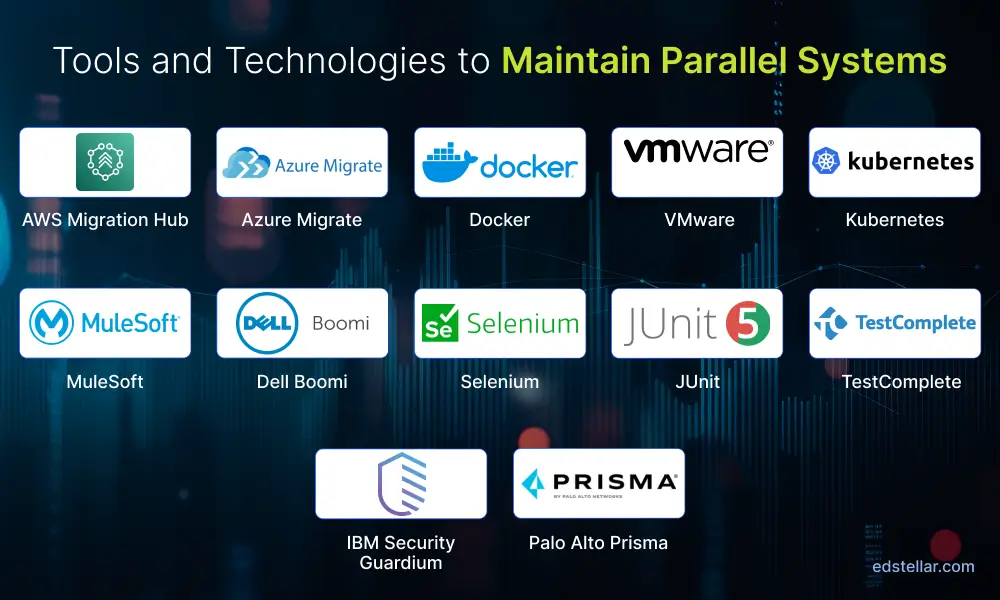
- Cloud migration frameworks (AWS Migration Hub, Azure Migrate, Google Cloud Migrate), as well as containers and virtualization tools such as Docker, VMware, and Kubernetes
- Middleware such as MuleSoft and Dell Boomi helps ensure legacy and digital systems communicate effectively during the parallel phase
- Rely on test automation frameworks (Selenium, JUnit, TestComplete) to compare outputs of both systems
- Cybersecurity tools such as IBM Security Guardium or Palo Alto Prisma are crucial to protect sensitive data in the overlapping systems phase.
Here is a case study helping your company understanding why developing user-friendly digital systems is important:
- In banking, HSBC digitized its global payments system, it maintained the legacy COBOL-based system alongside its new cloud-native platform to reduce risks. Once the reliability of the new system was validated, the transition was fully executed
- In insurance, Allianz ran parallel customer claims systems for years while introducing AI-driven digital claims handling, ensuring no citizen’s data was lost and no claims were delayed
- In aviation, airlines Delta have maintained reservations and backend ticketing systems in parallel during upgrades to newer customer-facing mobile platforms.By doing so, they avoided the disruptions faced by competitors during system outages.
4. Adopt Artificial Intelligence for Automation and Decision Support
Artificial Intelligence (AI) for automation and decision support refers to the use of AI algorithms, machine learning models, and cognitive computing tools that can handle repetitive tasks, assist in predictive analysis, and provide businesses with actionable insights. This approach is increasingly adopted in banking, healthcare, manufacturing, retail, logistics, and even government operations, where organizations need to both scale efficiency and make smarter decisions.
This strategy addresses the skill gap in handling repetitive time-consuming tasks and the human limitations in processing massive volumes of data for fast decision-making. Businesses also face the challenge of mitigating human error, bias, and inefficiency, particularly when handling processes that require real-time responses, such as fraud detection or supply chain optimization.
To adopt and implement AI for automation and decision support, leaders need follow the below steps:
- Identifying processes that align with automation potential, such as customer service chats, transaction validation, or demand forecasting.
- Organizations should gather comprehensive, clean datasets that serve as the foundation for training reliable AI models
- Teams should select the most appropriate AI technology, whether machine learning, natural language processing, or computer vision, depending on the business use case
- Pilot programs are to be launched with defined KPIs to measure efficiency gains or decision accuracy improvements
- Once pilot results prove consistent, AI integrated into additional workflows to carry out scaling analysis.
The technologies and tools that are valued while adopting AI for automation and decision support include the following:
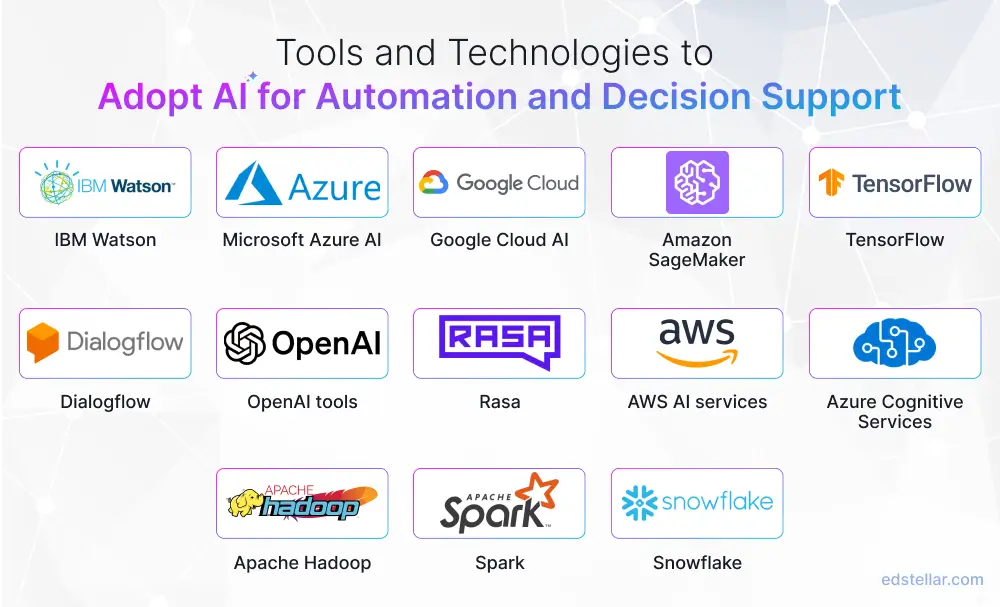
- IBM Watson, Microsoft Azure AI, Google Cloud AI, Amazon SageMaker, and TensorFlow for implementing robust models
- Conversational interfaces, Dialogflow, OpenAI tools, and Rasa are common technologies.
- Organizations seeking automation integrate AI with ERP, CRM, and enterprise platforms to provide contextual decision support
- Cloud-based AI services such as AWS AI services or Azure Cognitive Services has become a key enabler by reducing infrastructure complexity
- Big data tools such as Apache Hadoop, Spark, and Snowflake are valued for supporting decision pipelines at scale
Miniature case studies from reputed companies post adopting AI for automation and decision support -
- In technology and engineering, Siemens implemented AI-driven predictive maintenance across its factory operations, significantly reducing downtime by anticipating equipment failures before they happened
- In finance, American Express enhanced fraud detection using AI, preventing billions of dollars in losses by analyzing transaction behaviors in real time
- In e-commerce, Netflix used AI-based recommendation engines not only for customer engagement but also for decision support in content licensing and inventory management.
- In healthcare, Mayo Clinic leverages AI for faster diagnosis by integrating diagnostic imaging analysis, assisting doctors with 94% faster detection times.
5. Implement Robotic Process Automation (RPA) for Repetitive Tasks
Robotic Process Automation (RPA) refers to the use of software bots to automate repetitive, rule-based processes within an organization. It is heavily applied in industries such as banking, finance, insurance, healthcare, retail, telecommunications, and logistics, where high transaction volumes and strict data accuracy are essential.
The main challenges this strategy addresses include the inefficiency of manual operations, high operational costs, susceptibility to human error, and low employee productivity. Traditional processes such as invoice handling, claims processing, data reconciliation, and payroll management can drain resources and slow down digital transformation if left manual.
RPA offers powerful benefits by reducing costs, speeding up processes, and ensuring accuracy at scale. To implement this RPA for repetitive tasks strategy - follow these steps:
- Conduct a process assessment to identify repetitive, standardized tasks suitable for automation
- Define process goals such as reducing invoice cycle times or improving data accuracy rates
- Pilot RPA solutions should be deployed on a small set of processes to assess impact
- Scale-up efforts must focus on enterprise-wide rollout, integrating bots across departments
- Govern and monitor frameworks should be established to ensure that automated processes remain compliant, updated, and error-free
The technologies and tools that are valued while implementing RPA for repetitive tasks:
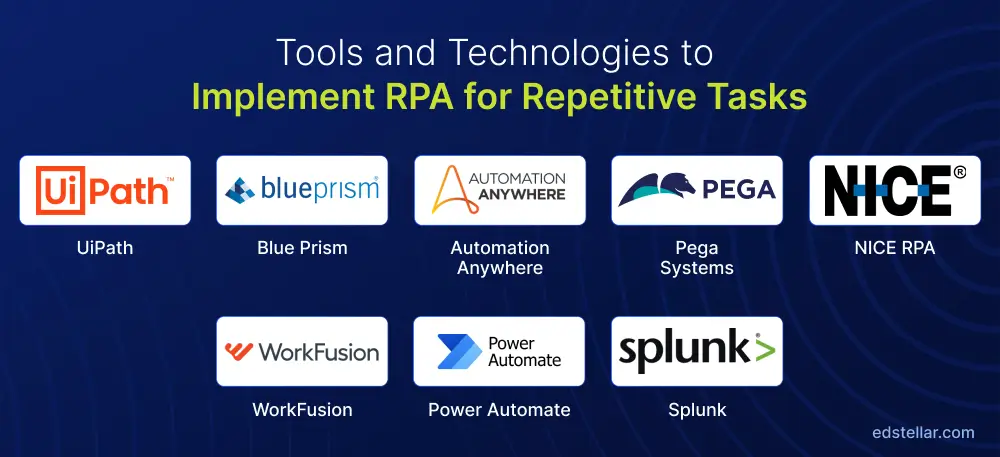
- UiPath, Blue Prism, Automation Anywhere, and Pega Systems
- Workflow orchestration systems such as NICE RPA and WorkFusion are widely valued for scaling enterprise-grade automation
- AI-enhanced RPA platforms integrating machine learning, natural language processing, and computer vision help businesses automate complex processes involving unstructured data such as scanned documents
- Cloud-based RPA services such as Power Automate and AWS Robomaker are highly valued for their flexibility
- Cybersecurity measures, monitoring platforms such as Splunk, and API integrations remain essential for effective and secure deployments
Case studies from reputed companies post implementing RPA for repetitive tasks -
- Financial service firms such as Deutsche Bank have reported cost savings of over $500 million annually through RPA in transaction processing
- In healthcare, the UK’s National Health Service (NHS) saved the work time of 2.5 full-time staff by using RPA for patient appointment scheduling and billing, significantly reducing administrative backlog
Conclusion
Implementing these integrated digital transformation strategies equips organizations with the tools and frameworks necessary for a successful digital journey. By ensuring systems can seamlessly connect, prioritizing intuitive user interactions, cautiously transitioning with parallel systems, and automating intelligent decision-making alongside routine tasks, companies can unlock significant cost savings, process efficiencies, and innovation opportunities.
Organizations such as Edstellar exemplify how workforce upskilling and tailored training play a vital role in enabling teams to maximize the impact of digital transformation initiatives across industries. Case studies from leading global organizations demonstrate the tangible impact of these strategies across finance, healthcare, technology, insurance, and beyond. As the digital environment continues to evolve, embracing these approaches holistically will remain critical for businesses looking to thrive amid rapid technological advances, shifting market demands, and increasing customer expectations.
Explore High-impact instructor-led training for your teams.
#On-site #Virtual #GroupTraining #Customized

Bridge the Gap Between Learning & Performance
Turn Your Training Programs Into Revenue Drivers.
Schedule a ConsultationEdstellar Training Catalog
Explore 2000+ industry ready instructor-led training programs.

Coaching that Unlocks Potential
Create dynamic leaders and cohesive teams. Learn more now!


Want to evaluate your team’s skill gaps?
Do a quick Skill gap analysis with Edstellar’s Free Skill Matrix tool

Transform Your L&D Strategy Today
Unlock premium resources, tools, and frameworks designed for HR and learning professionals. Our L&D Hub gives you everything needed to elevate your organization's training approach.
Access L&D Hub Resources.svg)
.svg)



.svg)


.svg)
.svg)
.svg)
.svg)

